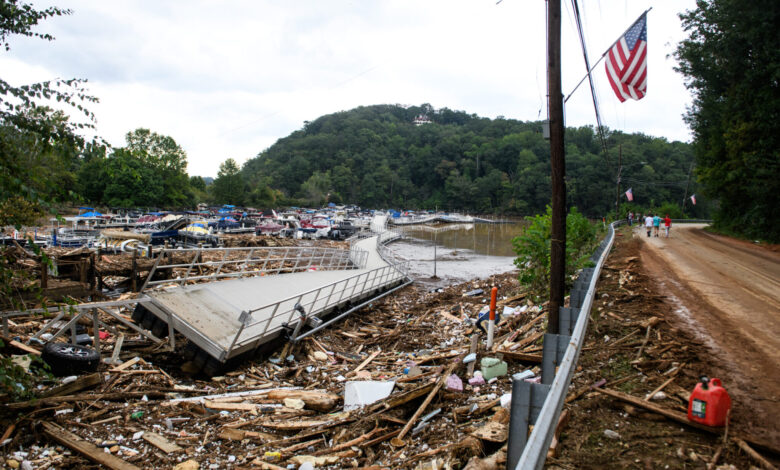How long it will take for Washington to act on emergency aid

WASHINGTON — Congress is likely to return from a six-week recess to approve emergency spending for Hurricane Helene recovery and response in the final days before an extremely close election.
Lawmakers won’t return to Washington, D.C., until after Election Day, Nov. 5, but President Joe Biden means Monday In a speech about the storm, he is likely to ask Congress to return quickly to address emergency spending requests.
Whether to do so will depend on House Speaker Mike Johnson, R-Louisiana, and Senate Majority Leader Chuck Schumer, D-N.Y.
How much pressure the two men feel to shorten the recess may depend on when the White House budget office sends an emergency supplemental spending request to Congress, how soon federal agencies expect to run out of cash and the urgency of the need.
As of Monday afternoon, the death toll in six states – Alabama, Florida, Georgia, North Carolina, South Carolina and Tennessee – exceeded 100, and White House advisers said hundreds more were missing. Two million people are without power, and many others lack water and cell phone service.
Scott calls for return
Florida Republican Sen. Rick Scott issued a statement calling on Schumer to bring the House back into session after the White House issued a request for emergency funding.
“While I know from past hurricane experience that FEMA and SBA damage assessments take time, I today urged Majority Leader Chuck Schumer to reconvene the U.S. Senate as soon as these assessments are completed so that we can pass a clean supplement Disaster funding bills, other disaster relief legislation, such as my federal disaster relief tax relief bill, are needed to ensure full recovery for families in all affected communities,” Scott wrote.
The process of putting together the White House’s supplemental spending request includes determining which federal departments and agencies have enough money to handle their disaster relief efforts and which ones need additional funding. This could take weeks, especially after a large-scale disaster like Helen’s.
As of Monday, Congress was more likely to return to Capitol Hill as planned on Nov. 12 and consider emergency spending then.
In the interim, staff on the House and Senate Appropriations Committees and leadership offices will likely begin negotiations on the supplemental spending package once the Office of Management and Budget actually issues the request.
Lawmakers could then pass the bill during the lame duck session in November or December, possibly attached to one or a series of overdue full-year government appropriations bills.
Rep. Kate Carmack, R-Fla. Say it on C-SPAN On Monday, she felt “very confident” Congress would approve emergency funding for disaster relief as members return to Washington, D.C.
“I’m absolutely sure there will be additions,” Carmack said. “I’m concerned that this will turn into a political football. Frankly, there is no room for politics in things like this when it comes to disasters and emergencies.
Disaster Relief Fund
Thanks to a provision Congress approved days ago and special warnings for emergencies, FEMA can spend as much money as possible on disaster recovery.
stopgap spending bill Congressional approval Last week, the federal government extended operations through Dec. 20, including a provision that would allow FEMA to spend money from disaster relief funds faster than otherwise allowed.
FEMA’s disaster relief fund can operate on something called “Emergency Needs Funding,” which the agency can use as a safety net when accounts run low.
Need funds immediately Allow FEMA to suspend According to the Congressional Research Service, “Funding for long-term recovery and mitigation projects is not available in the FEMA system” Report.
“These INF restrictions do not affect individual assistance or public assistance programs that compensate state and local authorities for emergency response efforts and protective measures implemented,” CRS said.
FEMA has tapped emergency needs multiple times, including after Hurricane Harvey made landfall in Texas in August 2017, in fiscal years 2003 to 2006, and in fiscal 2010, according to CRS.
Earlier funding requests were ignored
Biden administration send congress A supplemental spending request was made in October 2023 to provide additional funding for natural disaster response and recovery. A deeply divided Congress, with Republicans controlling the House of Representatives and Democrats holding a slim majority in the Senate, did not approve the request.
Office of Management and Budget Director Shalanda Young Sent another letter to Congress In June, lawmakers were urged to approve billions of dollars in additional funding for natural disasters.
Yang wrote that she wanted to “reiterate her October request and submit a revised estimate for an additional $4 billion for certain disaster needs, including to help respond to the collapse of the Francis Scott Key Bridge in Baltimore, last summer’s devastating Maui fires, and tornado survivors in Iowa, Nebraska, Oklahoma and throughout the Midwest.
“Especially as we enter what the National Oceanic and Atmospheric Administration describes as an ‘extraordinary’ hurricane season, the Administration urges Congress to act immediately on this request, including the Federal Emergency Management Agency (FEMA) Disaster Relief Fund (DRF), to Ensure we can meet our federal government’s responsibilities to rebuild from past disasters and respond to future events,” Yang wrote at the time.
Supplemental spending requests that the Biden administration sends to Congress in the coming weeks are likely to build on previous requests.
White House press secretary Karine Jean-Pierre said at a press briefing on Monday that the Biden administration is “disappointed” that Congress has not yet approved the supplemental spending request.
“We’re disappointed this didn’t work out,” she said. “We will continue to have this conversation. As the president said, we are in constant communication with members of Congress and we want to make sure they act quickly.
